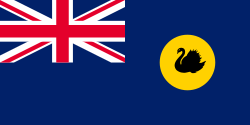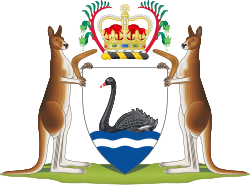Western Australia
 From Wikipedia - Reading time: 35 min
From Wikipedia - Reading time: 35 min
Western Australia | |
|---|---|
Nickname(s):
| |
Location of Western Australia in Australia 26°S 121°E / 26°S 121°E | |
| Country | Australia |
| Before federation | Colony of Western Australia |
| Established as the Swan River Colony | 2 May 1829 |
| Responsible government | 21 October 1890 |
| Federation | 1 January 1901 |
| Capital and largest city | Perth |
| Administration | 139 local government areas |
| Demonym(s) |
|
| Government | |
• Monarch | Charles III |
• Governor | Chris Dawson |
• Premier | Roger Cook (Labor) |
| Legislature | Parliament of Western Australia |
| Legislative Council | |
| Legislative Assembly | |
| Judiciary | Supreme Court of Western Australia |
| Parliament of Australia | |
• Senate | 12 senators (of 76) |
| 16 seats (of 150) | |
| Area | |
• Total | 2,527,013[1] km2 (975,685 sq mi) (1st) |
| Highest elevation | 1,249 m (4,098 ft) |
| Population | |
• December 2024 estimate | 3,008,700[2] (4th) |
• Density | 1.11/km2 (2.9/sq mi) (7th) |
| GSP | 2022 estimate |
• Total | A$377.257B[3] (4th) |
• Per capita | A$135,320 (1st) |
| HDI (2021) | very high · 2nd |
| Time zone |
|
| Postal abbreviation | WA |
| ISO 3166 code | AU–WA |
| Symbols | |
| Bird | Black swan (Cygnus atratus) |
| Fish | Whale shark (Rhincodon typus) |
| Flower | Red and green kangaroo paw (Anigozanthos manglesii) |
| Mammal | Numbat (Myrmecobius fasciatus) |
| Colour(s) | Black and gold |
| Fossil | Gogo fish (Mcnamaraspis kaprios) |
| Website | wa |
Western Australia (WA) is the westernmost state of Australia. It is bounded by the Indian Ocean to the north and west, the Southern Ocean to the south, the Northern Territory to the north-east, and South Australia to the south-east. Western Australia is Australia's largest state, with a land area of 2,527,013 square kilometres (975,685 sq mi),[5] and is also the second-largest subdivision of any country on Earth.[a]
Western Australia has a diverse range of climates, including tropical conditions in the Kimberley, deserts in the interior (including the Great Sandy Desert, Little Sandy Desert, Gibson Desert, and Great Victoria Desert) and a Mediterranean climate on the south-west and southern coastal areas. As of June 2024,[update] the state has 2.965 million inhabitants—10.9 percent of the national total.[6] Over 90 percent of the state's population live in the south-west corner and around 80 percent live in the state capital Perth,[7] leaving the remainder of the state sparsely populated. The Trans-Australian Railway and the Eyre Highway traverse the Nullarbor Plain in the state's south-east, providing the principal connection between Western Australia and the population centres in the eastern states.
Western Australia's Indigenous peoples have been present for tens of thousands of years. Dutch explorers visited Western Australia from the 17th century, with Dirk Hartog's 1616 expedition the first Europeans to make landfall. The British claimed Western Australia in 1827 and established the Swan River Colony with Perth as its capital in 1829. The Western Australian gold rushes of the late 19th century resulted in a significant population influx. The colony was granted responsible government in 1890, the last of the Australian colonies to become self-governing, and federated with the other colonies in 1901.
Western Australia's mining sector is a key driver of the state economy. The late 20th century saw the development of the state's significant iron ore mining industry – the world's largest – as well as primarily offshore petroleum and natural gas resources. Gold mining retains a significant presence and many other mineral commodities are mined, with Perth being a major centre for associated services. Outside of mining, primary industry is the other significant contributor to the state's economy, including agriculture in the Wheatbelt and temperate southern coastal regions, pastoralism in marginal grassland areas, forestry in the south-west and fishing (including pearling and, historically, whaling).
History
[edit]Western Australia has a geological history dating back to 4.4 billion years ago when Hadean zircons were formed. The earliest direct known life on land, known as stromatolites, started to be created by microbes at around 3.48 billion years ago.
The first human inhabitants of Australia arrived from the north "over 50,000 years ago and possibly as much as 70,000 years ago".[8]: 5 Over thousands of years they eventually spread across the whole landmass.[citation needed] These Indigenous Australians were long established throughout Western Australia by the time European explorers began to arrive in the early 17th century.
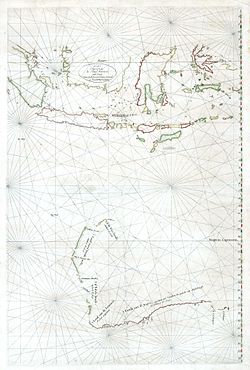
The first Europeans to visit Western Australia were those of the Dutch Dirk Hartog expedition, who on 25 October 1616 landed at what is now known as Cape Inscription, Dirk Hartog Island. For the rest of the 17th century, other Dutch and British navigators encountered the coast of what Abel Tasman named New Holland in 1644, usually unintentionally as demonstrated by the many shipwrecks along the coast of ships that deviated from the Brouwer Route (because of poor navigation and storms).[11] By the late 18th century, British and French sailors had begun to explore the Western Australian coast. The Baudin expedition of 1800–03 included the coast of Western Australia and resulted in the Freycinet Map of 1811, the first published map featuring the full outline of Australia. The name New Holland remained in popular and semi-official use until at least the mid-1850s; that is, it was in use for about 206 years in comparison to the name Australia which to date has been in use for about 196 years.[12]: 11
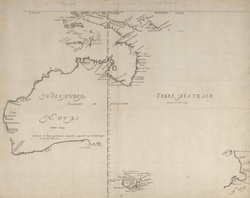
The origins of the present state began with the establishment by Lockyer[15] of a convict-supported settlement from New South Wales at King George III Sound. The settlement was formally annexed on 21 January 1827 by Lockyer when he commanded the Union Jack be raised and a feu de joie fired by the troops. The settlement was founded in response to British concerns about the possibility of a French colony being established on the coast of Western Australia.[15] On 7 March 1831 it was transferred to the control of the Swan River Colony,[16] and named Albany in 1832.
In 1829 the Swan River Colony was established on the Swan River by Captain James Stirling. By 1832, the British settler population of the colony had reached around 1,500, and the official name of the colony was changed to Western Australia on 6 February that year.[17][18] The two separate townsites of the colony developed slowly into the port city of Fremantle and the state's capital, Perth. York was the first inland settlement in Western Australia, situated 97 kilometres (60 mi) east of Perth and settled on 16 September 1831. York was the staging point for early explorers who discovered the rich gold reserves of Kalgoorlie.
Population growth was very slow until significant discoveries of gold were made in the 1890s around Kalgoorlie.

In 1887, a new constitution was drafted, providing for the right of self-governance of European Australians, and in 1890, the act granting self-government to the colony was passed by the British Parliament. John Forrest became the first Premier of Western Australia.
In 1896, after discoveries of gold at Coolgardie and Kalgoorlie, the Western Australian Parliament authorised the raising of a loan to construct a pipeline to transport 23 megalitres (5 million imperial gallons) of water per day to the burgeoning population on the goldfields. The pipeline, known as the Goldfields Water Supply Scheme, was completed in 1903. C. Y. O'Connor, Western Australia's first engineer-in-chief, designed and oversaw the construction of the pipeline. It carries water 530 km (330 mi) from Perth to Kalgoorlie, and is attributed by historians as an important factor driving the state's population and economic growth.[19]
Following a campaign led by Forrest, electors of the colony of Western Australia voted in favour of federation with the five other Australian colonies, resulting in Western Australia officially becoming a state on 1 January 1901.[20]
"West Australia"
[edit]
"West Australia" and its related demonym "West Australian" are occasionally used, including in the names of the main daily newspaper, The West Australian, and the state-based West Australian Football League, but are rarely used in an official sense. The terms "Westralia" and "Westralian" were regularly used in the 19th and 20th century.[21][22] The terms are still found in the names of certain companies and buildings, e.g. Westralia House in Perth, the skyscraper Westralia Square on St Georges Terrace, and Westralia Airports Corporation, which operates Perth Airport, as well as in the names of several ships.[23][24]
Geography
[edit]Western Australia is bounded to the east by longitude 129°E, the meridian 129 degrees east of Greenwich, which defines the border with South Australia and the Northern Territory, and bounded by the Indian Ocean to the west and north. The International Hydrographic Organization (IHO) designates the body of water south of the continent as part of the Indian Ocean; in Australia it is officially gazetted as the Southern Ocean.[b][25][26]
The total length of the state's eastern border is 1,862 km (1,157 mi).[27] There are 20,781 km (12,913 mi) of coastline, including 7,892 km (4,904 mi) of island coastline.[28] The total land area occupied by the state is 2.5 million km2 (970 thousand sq mi).[29]
Geology
[edit]The bulk of Western Australia consists of the extremely old Yilgarn craton and Pilbara craton which merged with the Deccan Plateau of India, Madagascar and the Kaapvaal and Zimbabwe cratons of Southern Africa, in the Archean Eon to form Ur, one of the oldest supercontinents on Earth (3–3.2 billion years ago). In May 2017, evidence of the earliest known life on land may have been found in 3.48-billion-year-old geyserite and other related mineral deposits (often found around hot springs and geysers) uncovered in the Pilbara craton.[30][31]
Because the only mountain-building since then has been of the Stirling Range with the rifting from Antarctica, the land is extremely eroded and ancient, with no part of the state above 1,249 metres (4,098 ft) AHD (at Mount Meharry in the Hamersley Range of the Pilbara region). Most of the state is a low plateau with an average elevation of about 400 metres (1,200 ft), very low relief, and no surface runoff. This descends relatively sharply to the coastal plains, in some cases forming a sharp escarpment (as with the Darling Range/Darling Scarp near Perth).

The extreme age of the landscape has meant that the soils are remarkably infertile and frequently laterised. Even soils derived from granitic bedrock contain an order of magnitude less available phosphorus and only half as much nitrogen as soils in comparable climates in other continents. Soils derived from extensive sandplains or ironstone are even less fertile, nearly devoid of soluble phosphate and deficient in zinc, copper, molybdenum and sometimes potassium and calcium.
The infertility of most of the soils has required heavy application by farmers of fertilisers. These have resulted in damage to invertebrate and bacterial populations.[citation needed] The grazing and use of hoofed mammals and, later, heavy machinery through the years have resulted in compaction of soils and great damage to the fragile soils.
Large-scale land clearing for agriculture has damaged habitats for native flora and fauna. As a result, the South West region of the state has a higher concentration of rare, threatened or endangered flora and fauna than many areas of Australia, making it one of the world's biodiversity "hot spots". Large areas of the state's wheatbelt region have problems with dryland salinity and the loss of fresh water.
Climate
[edit]
The southwest coastal area has a Mediterranean climate. It was originally heavily forested, including large stands of karri, one of the tallest trees in the world.[32] This agricultural region is one of the nine most bio-diverse terrestrial habitats, with a higher proportion of endemic species than most other equivalent regions. Thanks to the offshore Leeuwin Current, the area is one of the top six regions for marine biodiversity and contains the most southerly coral reefs in the world.
Average annual rainfall varies from 300 millimetres (12 in) at the edge of the Wheatbelt region to 1,400 millimetres (55 in) in the wettest areas near Northcliffe, but from November to March, evaporation exceeds rainfall, and it is generally very dry. Plants are adapted to this as well as the extreme poverty of all soils.
The central two-thirds of the state is arid and sparsely inhabited. The only significant economic activity is mining. Annual rainfall averages less than 300 millimetres (8–10 in), most of which occurs in sporadic torrential falls related to cyclone events in summer.[33]
An exception to this is the northern tropical regions. The Kimberley has an extremely hot monsoonal climate with average annual rainfall ranging from 500 to 1,500 millimetres (20–60 in), but there is a very long almost rainless season from April to November. Eighty-five percent of the state's runoff occurs in the Kimberley, but because it occurs in violent floods and because of the insurmountable poverty of the generally shallow soils, the only development has taken place along the Ord River.
Snow is rare in the state and typically occurs only in the Stirling Range near Albany, as it is the only mountain range far enough south and sufficiently elevated. More rarely, snow can fall on the nearby Porongurup Range. Snow outside these areas is a major event; it usually occurs in hilly areas of southwestern Australia. The most widespread low-level snow occurred on 26 June 1956 when snow was reported in the Perth Hills, as far north as Wongan Hills and as far east as Salmon Gums. However, even in the Stirling Range, snowfalls rarely exceed 5 cm (2 in) and rarely settle for more than one day.[34]
The highest observed temperature of 50.7 °C (123.3 °F) was recorded in Onslow on 13 January 2022.[35] The lowest temperature recorded was −7.2 °C (19.0 °F) at Eyre Bird Observatory on 17 August 2008.[36]
The south geomagnetic pole is currently tilted 10 degrees away from the South Pole towards Western Australia, allowing for aurora australis displays as far north as Geraldton.[37]
| Climate data for Western Australia | |||||||||||||
|---|---|---|---|---|---|---|---|---|---|---|---|---|---|
| Month | Jan | Feb | Mar | Apr | May | Jun | Jul | Aug | Sep | Oct | Nov | Dec | Year |
| Record high °C (°F) | 50.7 (123.3) |
50.5 (122.9) |
48.1 (118.6) |
45.0 (113.0) |
40.6 (105.1) |
37.8 (100.0) |
38.3 (100.9) |
41.6 (106.9) |
43.1 (109.6) |
46.9 (116.4) |
48.0 (118.4) |
49.8 (121.6) |
50.7 (123.3) |
| Record low °C (°F) | 0.9 (33.6) |
0.5 (32.9) |
−0.8 (30.6) |
−2.2 (28.0) |
−5.6 (21.9) |
−6.0 (21.2) |
−6.7 (19.9) |
−7.2 (19.0) |
−5.1 (22.8) |
−5.0 (23.0) |
−2.1 (28.2) |
0.0 (32.0) |
−7.2 (19.0) |
| Source 1: Bureau of Meteorology[38] | |||||||||||||
| Source 2: [35][39][full citation needed] | |||||||||||||
Flora and fauna
[edit]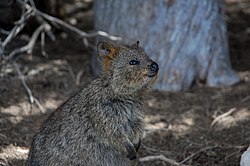
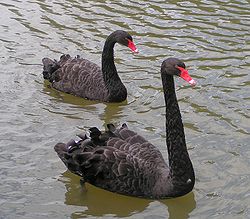
Western Australia is home to around 630 species of birds (depending on the taxonomy used). Of these around 15 are endemic to the state. The best areas for birds are the southwestern corner of the state and the area around Broome and the Kimberley.
The Flora of Western Australia comprises 10,162 published native vascular plant species, along with a further 1,196 species currently recognised but unpublished. They occur within 1,543 genera from 211 families; there are also 1,276 naturalised alien or invasive plant species, more commonly known as weeds.[40][41] In the southwest region are some of the largest numbers of plant species for its area in the world.
Western Australia's ecoregions include the sandstone gorges of the Kimberley on the northern coast, and below that the drier Victoria Plains tropical savanna inland, and the semi-desert Pilbara shrublands, Carnarvon xeric shrublands, and Western Australian mulga shrublands to the southwest. Southwards along the coast are the Southwest Australia savanna and the Swan Coastal Plain around Perth, with the Jarrah-Karri forest and shrublands on the southwest corner of the coast around the Margaret River wine-growing area. Going east along the Southern Ocean coast is the Goldfields-Esperance region, including the Esperance mallee and the Coolgardie woodlands inland around town of Coolgardie. Deserts occupy the interior, including the Great Sandy-Tanami desert, Gibson Desert, Great Victoria Desert, and Nullarbor Plain.
In 1831, Scottish botanist Robert Brown produced a scientific paper, titled General view of the botany of the vicinity of Swan River. It discusses the vegetation of the Swan River Colony.[42]
Demographics
[edit]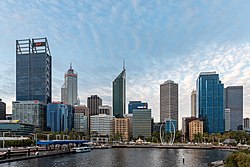
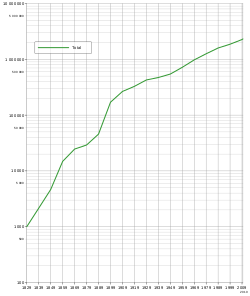
Europeans began to settle permanently in 1826 when Albany was claimed by Britain to forestall French claims to the western third of the continent. Perth was founded as the Swan River Colony in 1829 by British and Irish settlers, though the outpost languished. Its officials eventually requested convict labour to augment its population. By the time transportation ceased in 1868, convicts outnumbered free settlers 9,700 to 7,300.[43] In the 1890s, interstate immigration, resulting from a mining boom in the Goldfields region, resulted in a sharp population increase.
Western Australia did not receive significant flows of immigrants from Britain, Ireland or elsewhere in the British Empire until the early 20th century. At that time, its local projects—such as the Group Settlement Scheme of the 1920s, which encouraged farmers to settle the southwest—increased awareness of Australia's western third as a destination for colonists.
Led by immigrants from the British Isles, Western Australia's population developed at a faster rate during the twentieth century than it had previously. After World War II, both the eastern states and Western Australia received large numbers of Italians, Croatians and Macedonians. Despite this, Britain has contributed the greatest number of immigrants to this day. Western Australia—particularly Perth—has the highest proportion of British-born of any state: 10.3% in 2011, compared to a national average of 5.1%. This group is heavily concentrated in certain parts, where they account for a quarter of the population.[44]
Perth's metropolitan area (including Mandurah) had an estimated population of 2,043,138[7] in June 2017 (79% of the state). Other significant population centres include Bunbury (73,989),[45] Geraldton (37,961),[45] Kalgoorlie-Boulder (30,420),[45] Albany (33,998),[45] Karratha (16,446),[45] Broome (14,501)[45] and Port Hedland (14,285).[45]
Ancestry and immigration
[edit]| Birthplace[c] | Population |
|---|---|
| Australia | 1,492,842 |
| England | 194,163 |
| New Zealand | 79,221 |
| India | 49,385 |
| South Africa | 41,008 |
| Philippines | 30,835 |
| Malaysia | 29,126 |
| Mainland China | 27,126 |
| Scotland | 26,063 |
| Italy | 19,210 |
At the 2016 census, the most commonly nominated ancestries were:[d][46][47]
- English (40.7%)
- Australian (33.2%)[e]
- Irish (9.8%)
- Scottish (9.4%)
- Italian (5.4%)
- Chinese (4.5%)
- German (3.2%)
- Indigenous (3.1%)[f]
- Indian (3%)
- Dutch (2.1%)
- Filipino (1.6%)
- New Zealander (1.4%)
- South African (1.3%)
- Maori (1.2%)
3.1% of the population, or 75,978 people, identified as Indigenous Australians (Aboriginal Australians and Torres Strait Islanders) in 2016.[f][46][47]
Language
[edit]At the 2016 census, 75.2% of inhabitants spoke only English at home, with the next most common languages being Mandarin (1.9%), Italian (1.2%), Vietnamese (0.8%), Cantonese (0.8%) and Tagalog (0.6%).[46][47]
Religion
[edit]According to the 2021 census, Christianity is the major religious affiliation in WA, followed by 41.1% of its population. In 1971, Christianity was followed by 85.5% of the population and it has been declining since, while the percentage of people who identified as having no religious affiliation has increased from 8.7% in 1971 to 42.9% in 2021. A small minority of the population are Muslims (2.5%), Buddhists (2.2%) and Hindus (2.0%).[49][50][47]
Economy
[edit]


Western Australia's economy is largely driven by extraction and processing of a diverse range of mineral and petroleum commodities. The structure of the economy is closely linked to these natural resources, providing a comparative advantage in resource extraction and processing. As a consequence:
- Western Australia contributes an estimated 58% of Australia's Mineral and Energy Exports,[51] potentially earning up to 4.64% of Australia's total GDP.[52]
- Gross state product per person ($97,940 in 2017–18) is higher than any other state and well above the national average ($73,267).[53]
- Diversification (i.e. a greater range of commodities) over the past 15 years has provided a more balanced production base and less reliance on just a few major export markets, insulating the economy from fluctuations in world prices to some extent.[citation needed]
- Finance, insurance and property services and construction have grown steadily and have increased their share of economic output.[54]
- Recent growth in global demand for minerals and petroleum, especially in China (iron-ore) and Japan (for LNG), has ensured economic growth above the national average.
In 2019 Western Australia's overseas exports accounted for 46% of the nation's total.[55][56] The state's major export commodities included iron-ore, petroleum, gold, alumina, nickel, wheat, copper, lithium, chemicals and mineral sands.[57]
Western Australia is the world's largest iron-ore producer (34% of the world's total), and extracts 66% (6.9% of world production) of Australia's 306 tonnes (9.8 million troy ounces) of gold in 2022.[58] It is a major world producer of bauxite, which is processed into alumina at four refineries providing 11% of total world production. Until 2020 diamonds were extracted from the world's largest diamond mine in the far north Kimberley region. Coal mined at Collie is the main fuel for baseload electricity generation in the state's south-west.[57][59]
Agricultural production in WA is a major contributor to the state and national economy. In the period 2010–2019 wheat production in WA has averaged nearly 10 million tonnes (22 billion pounds), valued at $2.816 billion in 2019, accounting for half the nation's total and providing $2–3 billion in export income.[60][61]
Other significant farm output includes wool, beef, lamb, barley, canola, lupins, oats and pulses.[60] There is a high level of overseas demand for live animals from WA, driven mainly by southeast Asia's feedlots and Middle Eastern countries, where Islamic dietary laws and a lack of storage and refrigeration facilities favour live animals over imports of processed meat. About half of Australia's live cattle exports come from Western Australia.[62]
Resource sector growth in recent years has resulted in significant labour and skills shortages, leading to recent efforts by the state government to encourage interstate and overseas immigration.[63] According to the 2006 census,[needs update][64] the median individual income was A$500 per week in Western Australia (compared to A$466 in Australia as a whole). The median family income was A$1246 per week (compared to A$1171 for Australia). Recent growth has also contributed to significant rises in average property values in 2006, although values plateaued in 2007.

Located south of Perth, the heavy industrial area of Kwinana had the nation's largest oil refinery with a capacity of 23,200 cubic metres per day (146,000 barrels per day) until its closure in 2021, producing most of the state's petrol and diesel.[65][66][67] Kwinana also hosts alumina and nickel processing plants, port facilities for grain and other bulk exports, and support industries for mining and petroleum such as heavy and light engineering, and metal fabrication. Shipbuilding (e.g. Austal) and associated support industries are found at nearby Henderson, just north of Kwinana. Significant secondary industries include cement and building product manufacturing, flour milling, food processing, animal feed production, automotive body building and printing.
Western Australia has a significant fishing industry. Products for local consumption and export include western rock lobsters, prawns, crabs, shark and tuna, as well as pearl fishing in the Kimberley region of the state. Processing is conducted along the west coast. Whaling was a key marine industry but ceased at Albany in 1978.
Western Australia has the world's biggest plantations of both Indian sandalwood (northern WA)[68] and Australian sandalwood (semi-arid regions), which are used to produce sandalwood oil and incense.[69] The WA sandalwood industry provides about 40% of the international sandalwood oil market.[70]
Tourism
[edit]
In the 2000s, tourism grew in importance, with significant numbers of visitors to the state in 2008 coming from the UK and Ireland (28%), other European countries (14%) Singapore (16%), Japan (10%) and Malaysia (8%).[61] Revenue from tourism is a strong economic driver in many of the smaller population centres outside of Perth, especially in coastal locations.
Tourism forms a major part of the Western Australian economy with 833,100 international visitors making up 12.8% of the total international tourism to Australia in the year ending March 2015. The top three source markets include the United Kingdom (17%), Singapore (10%), and New Zealand (10%) with the majority of purpose for visitation being holiday/vacation reasons.[71] The tourism industry contributes $9.3 billion to the Western Australian economy and supports 94,000 jobs within the state. Both directly and indirectly, the industry makes up 3.2% of the state's economy whilst comparatively, WA's largest revenue source, the mining sector, brings in 31%.[72]
Tourism WA is the government agency responsible for promoting Western Australia as a holiday destination.[73]
Government
[edit]
Western Australia was granted self-government in 1890[74] with a bicameral Parliament located in Perth, consisting of the Legislative Assembly (or lower house), which has 59 members; and the Legislative Council (or upper house), which has 36 members. Suffrage is universal and compulsory for citizens over 18 years of age.
With the federation of the Australian colonies in 1901, Western Australia became a state within Australia's federal structure; this involved ceding certain powers to the Commonwealth (or Federal) government in accordance with the Constitution; all powers not specifically granted to the Commonwealth remained solely with the State. However over time the Commonwealth has effectively expanded its powers through broad interpretation of its enumerated powers and increasing control of taxation and financial distribution (see Federalism in Australia).
Whilst the sovereign of Western Australia is the monarch of Australia (currently Charles III) and executive power is nominally vested in his or her state representative, the Governor (currently Chris Dawson), executive power rests with the premier and ministers drawn from the party or coalition of parties holding a majority of seats in the Legislative Assembly. Roger Cook is the premier, having succeeded Mark McGowan after his resignation in June 2023.
Secession
[edit]
Secessionism has been a recurring feature of Western Australia's political landscape since shortly after European settlement in 1826. Western Australia was the most reluctant participant in the Commonwealth of Australia.[75] Western Australia did not participate in the earliest federation conference. Longer-term residents of Western Australia were generally opposed to federation; however, the discovery of gold brought many immigrants from other parts of Australia. It was these residents, primarily in Kalgoorlie but also in Albany who voted to join the Commonwealth, and the proposal of these areas being admitted separately under the name Auralia was considered.[citation needed]
In a referendum in April 1933, 68% of voters voted for the state to leave the Commonwealth of Australia with the aim of returning to the British Empire as an autonomous territory. The State Government sent a delegation to Westminster, but the British Government ruled that after the Statute of Westminster 1931, it no longer had the authority to amend the constitution of Australia without the consent of its federal government; the British Government took no action.[76]
Local government
[edit]Western Australia is divided into 139 Local Government Areas, including Christmas Island and the Cocos (Keeling) Islands. Their mandate and operations are governed by the Local Government Act 1995.[77]
Education
[edit]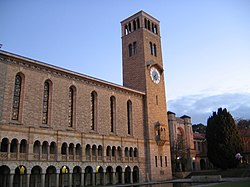
Education in Western Australia consists of one year of pre-school at age 4 or 5, followed by six years of primary education for all students as of 2015.[78] At age 12 or 13, students begin six years of secondary education. Students are required to attend school up until they are 16 years old. Sixteen and 17 year olds are required to be enrolled in school or a training organisation, be employed or be in a combination of school/training/employment.[79] Students have the option to study at a TAFE college after Year 10,[80] or continue through to Year 12 with vocational courses or a university entrance courses.[81]
There are five universities in Western Australia. They consist of four Perth-based public universities, being the University of Western Australia, Curtin University, Edith Cowan University and Murdoch University; and one Fremantle-based private Roman Catholic university, the University of Notre Dame Australia. The University of Notre Dame is also one of only two private universities in Australia, along with Bond University, a not-for-profit private education provider based in Gold Coast, Queensland.
Media
[edit]
Western Australia has two daily newspapers: the Seven West Media-owned tabloid The West Australian and the Kalgoorlie Miner. Also published is one weekend paper, The Weekend West, and one Sunday tabloid newspaper, which is also owned by Seven West Media after purchase from News Corporation's The Sunday Times. There are also 17 weekly community newspapers with distribution from Yanchep in the north to Mandurah in the south. There are two major weekly rural papers in the state, Countryman and the Australian Community Media-owned Farm Weekly. The national broadsheet publication The Australian is also available, although with sales per capita lagging far behind those in other states. WAtoday is an online newspaper owned by Nine Entertainment, focusing its coverage on Perth and Western Australia.
Television
[edit]Metropolitan Perth has five broadcast television stations;
- ABC TV WA. (Callsign: ABW – Channel 12 Digital)
- SBS WA. (Callsign: SBS – was on Channel 29 Digital – now Channel 7 Digital since the 2013 retune)
- Seven Network Perth. (Callsign: TVW – Channel 6 Digital)
- Nine Network Perth. (Callsign: STW – Channel 8 Digital)
- Network Ten Perth. (Callsign: NEW – Channel 11 Digital)
- Perth formerly had West TV, a free-to-air community television channel that began broadcasting in April 2010 and ceased broadcasting in February 2020. It replaced Access 31, which ceased broadcasting in August 2008.
Regional WA has a similar availability of stations as Perth. Geographically, it is one of the largest television markets in the world, including almost one-third of the continent.
- Golden West Network (GWN7). Owned by Seven West Media. (Callsigns: SSW South West, VEW Goldfields/Esperance, GTW Central West, WAW remote areas)
- WIN Television WA. Affiliated with Nine (Callsign: WOW)
- West Digital Television. Affiliated with Ten (Callsigns: SDW South West, VDW Goldfields/Esperance, GDW Central West, WDW remote areas)
- Regional WA used to have Westlink. An open-narrowcast community-based television channel that was only on satellite until Westlink's discontinuation in 2018. (Satellite only)

In addition, broadcasters operate digital multichannels:
- ABC HD (Carried by ABW)
- ABC TV Plus (Carried by ABW)
- ABC Me (Carried by ABW)
- ABC News (Carried by ABW)
- SBS HD (Carried by SBS)
- SBS Viceland (Carried by SBS)
- SBS World Movies (Carried by SBS)
- SBS Food (Carried by SBS)
- NITV (Carried by SBS)
- SBS WorldWatch (Carried by SBS)
- 7HD (Carried by TVW)
- 7TWO (Carried by TVW and affiliates)
- 7mate (Carried by TVW and affiliates)
- 7flix (Carried by TVW)
- Racing.com (Carried by TVW and affiliates)
- 9HD (Carried by STW and affiliates)
- 9Gem (Carried by STW and affiliates)
- 9Go! (Carried by STW and affiliates)
- 9Life (Carried by STW and affiliates)
- 9Rush (Carried by STW)
- Extra (Carried by STW)
- 10 Bold (Carried by NEW and affiliate)
- 10 Peach (Carried by NEW and affiliate)
- 10 Shake (Carried by NEW)
- 10 HD (Carried by NEW and affiliate)
- TVSN (Carried by NEW and affiliate)
- Gecko TV (Carried by NEW)
Pay TV services are provided by Foxtel, which acquired many of the assets and all the remaining subscribers of the insolvent Galaxy Television satellite service in 1998. Some metropolitan suburbs are serviced by Pay TV via cable; however, most of the metropolitan and rural areas can only access Pay TV via satellite.
Radio
[edit]Perth has many radio stations on both AM and FM frequencies. ABC stations include ABC NewsRadio (6PB 585 AM), ABC Radio Perth (6WF 720 AM), Radio National (6RN 810 AM), ABC Classic FM (6ABC 97.7FM) and Triple J (6JJJ 99.3FM). The six commercial stations are: Triple M (6PPM), Nova 93.7 (6PER), Mix 94.5 (6MIX), 96FM (6NOW) and AM 882 (6PR), AM 1080 (6iX) and AM 1116 (6MM)
The leading community radio stations are Curtin FM 100.1, 6RTR FM 92.1, Sonshine FM 98.5 (6SON) and 91.3 SportFM (6WSM).
Culture
[edit]Arts and entertainment
[edit]
Western Australia is home to one of the country's leading performance training institutions, the acclaimed Western Australian Academy of Performing Arts (WAAPA), as well as a burgeoning theatrical and musical scene. Notable musicians and bands to have been born in or lived in Western Australia include Adam Brand, Ammonia, Karnivool, Birds of Tokyo, Bon Scott, Eskimo Joe, Johnny Young, Gyroscope, the John Butler Trio, Tame Impala, Kevin Mitchell, Tim Minchin, Troye Sivan, the Kill Devil Hills, Pendulum, the Pigram Brothers, Rolf Harris, Stella Donnelly and the Triffids. The West Australian Music Industry Awards (WAMis) have been awarded every year to the leading musicians and performers in WA since 2001.
Notable actors and television personalities from Western Australia include Heath Ledger, Sam Worthington, Ernie Dingo, Jessica Marais, Megan Gale, Rove McManus, Isla Fisher, and Melissa George. Films and television series filmed or partly filmed in Western Australia include Rabbit-Proof Fence, The Heights, Mystery Road, These Final Hours, Cloudstreet, Jasper Jones, Australia, Bran Nu Dae, Red Dog, ABBA: the Movie and Last Train to Freo.
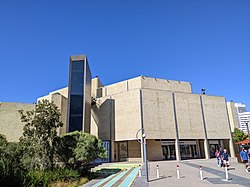
Noted Western Australian Indigenous painters and artisans include Jack Dale Mengenen, Paddy Bedford, Queenie McKenzie, and siblings Nyuju Stumpy Brown and Rover Thomas.[82]
The West Australian Symphony Orchestra (WASO) is based at the Perth Concert Hall. Other concert, performance and indoor sporting venues in Western Australia include His Majesty's Theatre, the State Theatre Centre of Western Australia, the Crown Theatre and Perth Arena, which opened in 2012. Performing arts companies based in Perth include the West Australian Ballet, the West Australian Opera, the Black Swan State Theatre Company and the Perth Theatre Company.
Western Australia has served as the setting for a number of works of Australian literature. Prominent authors include Katharine Susannah Prichard, Randolph Stow, Tim Winton, Kim Scott, Sally Morgan, Joan London, Mary Durack and Craig Silvey.
The public Art Gallery of Western Australia is part of the Perth Cultural Centre. Founded in 1895, it houses the State Art Collection, comprising works from local and international artists, dating back to the 1800s.[83] The Perth Cultural Centre is also home to the Western Australian Museum, State Library of Western Australia, State Records Office, and Perth Institute of Contemporary Arts (PICA). Western Australia has a public library system, with libraries in every local government area (although some public libraries are shared school libraries).
Sport
[edit]
A number of national or international sporting teams and events are based in the state, including:
- Australian rules football: The West Coast Eagles and the Fremantle Dockers compete in the Australian Football League (AFL). They also have women's teams playing in the AFL Women's league. The West Australian Football League (WAFL) is the main local football competition, but other local and amateur football leagues exist across the state.
- Baseball: The Perth Heat compete in the Australian Baseball League.
- Basketball: The Perth Wildcats (men) and Perth Lynx (women) compete in the National Basketball League and Women's National Basketball League, respectively.
- Cricket: Western Australia represent the state in first-class and List A domestic cricket, with the Perth Scorchers competing in the Twenty20 Big Bash League.
- Field hockey: The Thundersticks (men) and Diamonds (women) compete in the Australian Hockey League.
- Ice hockey: The Perth Thunder (men) and Perth Inferno (women) compete in Australian Ice Hockey League (AIHL).
- Netball: The West Coast Fever compete in the ANZ Championship.
- Rugby league: The West Coast Pirates compete in the S. G. Ball Cup.
- Rugby union: The Western Force competes in Super Rugby Pacific.
- Soccer: Perth Glory field men's and women's teams in the A-League Men and A-League Women, respectively.
- Tennis: The ITF Hopman Cup, an annual international team indoor hardcourt tennis tournament.
- Water Polo: The UWA Torpedoes water polo club competes in the National Water Polo League (NWPL).
International sporting events hosted in the past in Western Australia include the Tom Hoad Cup (water polo), the Perth International (golf), the 2006 Gravity Games (extreme sports), the 2002 Women's Hockey World Cup, the 1991 FINA World Aquatics Championships, the World Rally Championships and the 1962 British Empire and Commonwealth Games.

Western Australia's largest sports stadium is Perth Stadium, also known by naming rights sponsorship as Optus Stadium. It has a capacity of over 60,000 people and is primarily used for Australian rules football and cricket.
Wine
[edit]Winemaking regions are concentrated in the cooler climate of the south-western portion of the state. Western Australia produces less than 5% of the country's wine output, but in quality terms is considered to be very much near the top.[84][85][86][87] Major wine producing regions include: Margaret River, The Great Southern, Swan Valley as well as smaller districts including Blackwood Valley, Manjimup, Pemberton, Peel, Chittering Valley, Perth Hills, and Geographe.[86]
Public holidays
[edit]The table below outlines all recognised public holidays in Western Australia.
| Name | Date |
|---|---|
| New Year's Day* | 1 January |
| Australia Day* | 26 January |
| Labour Day | First Monday in March |
| Good Friday | Variable (aligns with Easter) (March or April) |
| Easter Sunday | Variable (aligns with Easter) (March or April) |
| Easter Monday | Variable (aligns with Easter) (March or April) |
| ANZAC Day* | 26 April |
| Western Australia Day | First Monday in June |
| King's Birthday | As proclaimed by the governor of Western Australia (September/October) |
| Christmas Day* | 25 December |
| Boxing Day* | 26 December |
- Indicates a nation wide holiday
Sister states
[edit]Western Australia has five sister states:[88]
- East Java, Indonesia
- Hyōgo Prefecture, Japan
- Andhra Pradesh State, India
- Tuscany Region, Italy
- Zhejiang Province, China
In 1981, a sister state agreement was drawn up between Western Australia and Hyōgo Prefecture in Japan that was aimed at improving cultural ties between the two states.[89][90] To commemorate the 10th anniversary of this agreement, the Hyōgo Prefectural Government Cultural Centre was established in Perth in 1992.[91] Prior to that, the Western Australian government opened an office in Kobe, the largest city in Hyōgo, to facilitate maintenance of the relationship in 1989.[90][92]
Following the Great Hanshin earthquake that devastated southern Hyōgo in January 1995, Western Australian groups and businesses raised funds and provided materials, whilst individuals travelled to Hyōgo to help with emergency relief and the subsequent reconstruction process.[93][94][95] The two governments signed a memorandum of understanding on the 20th anniversary in 2001 that aimed to improve the economic relationship between the two states.[90]
Further to the sister state relationship, the City of Rockingham in Western Australia and the City of Akō in Hyōgo signed a sister city agreement in 1997. It is one of nine sister city relationships between Western Australian and Japanese cities.[96]
See also
[edit]- Outline of Australia
- Index of Australia-related articles
- Government of Western Australia
- Mining in Western Australia
- Petroleum in Western Australia
Lists
[edit]- List of Western Australian towns
- List of statues in Western Australia
- Local Government Areas of Western Australia
- Category:Lists of people from Western Australia
Notes
[edit]- ^ Surpassed only by the Sakha Republic in eastern Russia, and formerly Northwest Territories in Canada, before the creation of Nunavut. It is also the largest proper subnational entity, being a state rather than a territory or an autonomous region.
- ^ In Australia, the body of water south of the continent is officially gazetted as the Southern Ocean, whereas the International Hydrographic Organization (IHO) designates it as part of the Indian Ocean.[25][26]
- ^ In accordance with the Australian Bureau of Statistics source, England, Scotland, Mainland China and the Special Administrative Regions of Hong Kong and Macau are listed separately
- ^ As a percentage of 2,286,107 persons who nominated their ancestry at the 2016 census.
- ^ The Australian Bureau of Statistics has stated that most who nominate "Australian" as their ancestry are part of the Anglo-Celtic group.[48]
- ^ a b Of any ancestry. Includes those identifying as Aboriginal Australians or Torres Strait Islanders. Indigenous identification is separate to the ancestry question on the Australian Census and persons identifying as Aboriginal or Torres Strait Islander may identify any ancestry.
References
[edit]- ^ "Area of Australia - States and Territories". 27 June 2014.
- ^ "National, state and territory population, December 2024 | Australian Bureau of Statistics". 19 June 2025.
- ^ "Western Australian Economic Notes – Gross State Product – 2021-22" (PDF). Archived from the original on 31 August 2021. Retrieved 16 September 2023.
- ^ "Sub-national HDI – Area Database – Global Data Lab". hdi.globaldatalab.org. Retrieved 18 February 2023.
- ^ "Area of Australia – States and Territories". Geoscience Australia, Commonwealth of Australia. 28 April 2023. Archived from the original on 26 July 2020. Retrieved 2 May 2023.
- ^ "National, state and territory population, March 2024 | Australian Department of Treasury". 22 March 2024.
- ^ a b "3218.0 – Regional Population Growth, Australia, 2016–17: Main Features". Australian Bureau of Statistics. 24 April 2018. Retrieved 13 October 2018. Estimated resident population, 30 June 2017.
- ^ Clare Menck (2022). A Thematic History of Western Australia (PDF). Perth: Heritage Council of Western Australia. OCLC 1347418300. Wikidata Q127496561. Archived (PDF) from the original on 29 October 2022. Retrieved 19 May 2024.
- ^ van Huystee, Marit (1995). On the yacht Duyfken (1601): The first European Ship known to explore the Australian coast (PDF). Western Australian Museum (Report). Maritime Archaeology Department Western Australian Maritime Museum. Archived (PDF) from the original on 14 February 2019. Retrieved 15 June 2024.
- ^ Gerritsz, Hessel (1618–1638). "Chart of the Malay Archipelago and the Dutch discoveries in Australia". Octroy Vande H.M. Heeren de Staten Generael der Vereenichde Neerlanden. The discoveries after 1618 were added to the engraved plate between 1628 and 1632. Amsterdam: Hessel Gerritsz. Retrieved 3 August 2020 – via Trove.
- ^ Green, J.N. (1977). "Australia's oldest wreck: The Loss of the Trial, 1622" (PDF). British Archaeological Reports, Supplementary Series. 27. Oxford.
- ^ W. M. Bartlett (1979). Western Australian Year Book (PDF). Western Australian Office: Australian Bureau of Statistics. ISSN 0083-8772. OCLC 223554105. Retrieved 13 September 2020.
- ^ Melchisédech Thévenot (1664). Relations de Divers Voyages Curieux (in French). Paris: Iacques Langlois. OCLC 1052538974. OL 33206638M. Wikidata Q130632460. Retrieved 24 October 2024.
- ^ Blaeu, Johannes Willemszoon (1659). "Archipelagus Orientalis sive Asiaticus (Karte 27)" [Archipelago Eastern or Asiatic (Map 27)]. Atlas des Großen Kurfürsten [Atlas of the Great Elector]. Amsterdam. Archived from the original on 4 August 2020. Retrieved 5 August 2020 – via Berlin State Library (German: Staatsbibliothek zu Berlin).
- ^ a b "King George's Sound Settlement". State Records Authority of New South Wales. Archived from the original on 11 September 2016. Retrieved 30 August 2016.
- ^ Knibbs, G.H. (1911). "The Creation of the Several Colonies". Official Year Book of the Commonwealth of Australia. Vol. 4. Melbourne: Commonwealth Bureau of Census and Statistics. p. 16.
- ^ "Swan River Colony Proclaimed". POI Australia. 2 May 1829. Retrieved 13 February 2021.
- ^ "On this day, 6th February 1832". State Library of New South Wales. Retrieved 13 February 2021.
- ^ Tauman, Merab Harris (1988). "Charles Yelverton O'Connor (1843–1902)". Australian Dictionary of Biography. National Centre of Biography, Australian National University. pp. 51–54. ISBN 978-0-522-84459-7. ISSN 1833-7538. OCLC 70677943. Retrieved 8 August 2025.
- ^ Hawkins, John Robert (2007). "John Forrest: Four times treasurer" (PDF). University of Canberra. Retrieved 3 May 2023.
- ^ "SLWA Online Catalogue /Entire Sta". Henrietta.liswa.wa.gov.au. Archived from the original on 9 November 2011. Retrieved 2 November 2012.
- ^ "Search results for 'westralia' – Trove". Trove.nla.gov.au. Retrieved 16 September 2015.
- ^ "SLWA Online Catalogue /Entire Sta". Henrietta.liswa.wa.gov.au. Archived from the original on 9 November 2011. Retrieved 2 November 2012.
- ^ "SLWA Online Catalogue /Entire Sta". Henrietta.liswa.wa.gov.au. Archived from the original on 9 November 2011. Retrieved 2 November 2012.
- ^ a b Limits of Oceans and Seas (PDF). Special Publication No. 23 (3rd ed.). Monte Carlo: International Hydrographic Organization. 1953. Archived from the original (PDF) on 7 October 2009. Retrieved 24 September 2021.
- ^ a b "Canberra all at sea over position of Southern Ocean". The Age. 22 December 2003. OCLC 224683742. Retrieved 29 January 2025.
- ^ "State And Territory Borders". Geoscience Australia. 11 September 2007. Archived from the original on 28 November 2007. Retrieved 25 September 2008.
- ^ "Coastline Lengths". Geoscience Australia. 18 November 2010. Archived from the original on 22 January 2011. Retrieved 21 January 2011.
- ^ "Area of States and Territories". Geoscience Australia. 31 August 2005. Archived from the original on 30 July 2008. Retrieved 25 September 2008.
- ^ "Oldest evidence of life on land found in 3.48-billion-year-old Australian rocks". Phys.org. 9 May 2017. Retrieved 13 May 2017.
- ^ Djokic, Tara; Van Kranendonk, Martin J.; Campbell, Kathleen A.; Walter, Malcolm R.; Ward, Colin R. (9 May 2017). "Earliest signs of life on land preserved in ca. 3.5 Ga hot spring deposits". Nature Communications. 8 15263. Bibcode:2017NatCo...815263D. doi:10.1038/ncomms15263. PMC 5436104. PMID 28486437.
- ^ "Climate of Western Australia". Bureau of Meteorology. Archived from the original on 17 March 2009. Retrieved 6 December 2009.
- ^ "Average annual, seasonal and monthly rainfall". Commonwealth of Australia, Bureau of Meteorology. 26 October 2011. Retrieved 1 June 2014.
- ^ Snow in Western Australia: About Snow in WA Archived 11 May 2011 at the Wayback Machine. Retrieved 4 February 2007.
- ^ a b "Australia equals hottest day on record at 50.7C". BBC. 13 January 2022. Retrieved 13 January 2022.
- ^ "Rainfall and Temperature Records: National" (PDF). Bureau of Meteorology. Retrieved 14 November 2009.
- ^ Logan, Tyne (29 April 2023). "Southern lights events expected to increase over next two years as sun reaches solar maximum". ABC News. Retrieved 9 December 2023.
- ^ "Australian Daily Extremes Table". Bureau of Meteorology. Retrieved 25 November 2020.
- ^ "x.com". X (formerly Twitter).
- ^ "2016 Vascular Flora Statistics". Flora Base. Retrieved 3 June 2017.
- ^ "New linear systematic sequence for vascular plants". Flora Base. Archived from the original on 15 February 2017. Retrieved 3 June 2017.
- ^ Diels, Ludwig (1981). "Extra-tropical Western Australia". In Carr, D. J.; Carr, S. G. M. (eds.). People and plants in Australia. Translated by Carr, D. J. Academic Press Australia. pp. 47–78. ISBN 978-0-12-160720-3.
- ^ "Founding of Perth". National Museum of Australia, Government of Australia. 4 May 2023. Retrieved 16 June 2024.
Between 1850 and 1868 around 10,000 British convicts arrived at the colony. By 1868 the total population was 17,000, with convicts outnumbering settlers, 9700 to 7300.
- ^ "Country of Birth" (xls). Australian Bureau of Statistics. 1 October 2014. Retrieved 27 October 2014.
- ^ a b c d e f g "3218.0 – Regional Population Growth, Australia, 2016–17: Population Estimates by Significant Urban Area, 2007 to 2017". Australian Bureau of Statistics. 24 April 2018. Retrieved 12 October 2018. Estimated resident population, 30 June 2017.
- ^ a b c d "2016 Census Community Profiles: Western Australia". quickstats.censusdata.abs.gov.au. Archived from the original on 13 March 2022. Retrieved 22 June 2019.
- ^ a b c d e "2016 – Census Output". www.censusdata.abs.gov.au/. Archived from the original on 15 March 2019. Retrieved 22 June 2019.
- ^ Jupp, James (January 1995). "Feature Article – Ethnic and Cultural Diversity in Australia (Feature Article)". abs.gov.au.
- ^ "Snapshot of Western Australia". Australian Bureau of Statistics. 24 July 2022. Archived from the original on 24 July 2022. Retrieved 24 July 2022.
- ^ Australian Bureau of Statistics (27 June 2017). "Western Australia". 2016 Census QuickStats. Retrieved 26 June 2019.
- ^ "Quick Resource Facts". Department of Mines & Petroleum. 9 November 2011. Archived from the original on 11 March 2011. Retrieved 9 November 2011.
- ^ "Australian Bureau of Statistics". Australian Bureau of Statistics. 9 November 2011. Retrieved 9 November 2011.
- ^ "Australian National Accounts: State Accounts, 2017–18". Australian Bureau of Statistics. 16 November 2018. Retrieved 19 April 2019.
- ^ Structure of the WA Economy (PDF). WA Department of Treasury and Finance. August 2005. ISBN 0-7307-4546-5. Archived from the original (PDF) on 1 October 2008. Retrieved 10 September 2008.
- ^ Curran, Enda (21 February 2012). "Western Australia Plans Sovereign Wealth Fund". The Wall Street Journal. Retrieved 15 March 2012.
- ^ "Australian Economic Indicators" (PDF). Australian Bureau of Statistics. 2008. Retrieved 11 September 2008.
- ^ a b "Western Australia Economic Profile" (PDF). Perth, WA: Government of Western Australia, Department of Jobs, Tourism, Science and Innovation. March 2020. p. 8. Archived from the original (PDF) on 26 September 2020. Retrieved 17 April 2020.
- ^ "Australia's Identified Mineral Resources 2023". Geoscience Australia. 31 December 2022. Retrieved 12 June 2024.
- ^ Mineral commodity summaries 2023. Reston, Virginia: U.S. Geological Survey. 31 January 2023. doi:10.3133/mcs2023. ISBN 978-1-4113-4504-1. Retrieved 2 May 2023.
- ^ a b Wilkinson, Ian (9 April 2019). "Western Australian wheat industry". South Perth, WA: Department of Primary Industries and Regional Development, Agriculture and Food division. Retrieved 17 April 2020.
- ^ a b "WA at a Glance 2008" (PDF). Australian Bureau of Statistics. 2 April 2008. Retrieved 10 September 2008.
- ^ "2008 Live Exports" (PDF). ABARE. 31 March 2008. p. 9. Archived from the original (PDF) on 19 July 2008. Retrieved 15 September 2008.
- ^ "Go West Now". Government of Western Australia. 2008. Archived from the original on 21 November 2011. Retrieved 16 September 2008.
- ^ "2006 Census QuickStats: Western Australia, October 2007". Censusdata.abs.gov.au. Archived from the original on 9 December 2013. Retrieved 14 June 2010.
- ^ "Refining". BP. Archived from the original on 25 August 2016. Retrieved 30 August 2016.
- ^ McKinnon, Stuart (3 April 2014). "BP sticks by Kwinana despite Qld closure". The West Australian. Retrieved 27 October 2014.
- ^ "Downstream_Petroleum 2007 Report" (PDF). Australian Institute of Petroleum. 15 July 2008. Archived from the original (PDF) on 1 October 2008. Retrieved 12 September 2008.
- ^ Jasper, Clint (21 March 2017). "Tropical Forestry Services becomes Quintis as the company shifts focus". ABC News (Australian Broadcasting Corporation). Retrieved 19 September 2020.
- ^ "Frequently Asked Questions". WA Sandalwood Plantations. Retrieved 19 September 2020.
- ^ Stevens, Rhiannon; Moussalli, Isabel (5 September 2020). "From the Gibson Desert to New York, these sandalwood harvesters are winning over the perfume market". ABC News (Australian Broadcasting Corporation). Retrieved 19 September 2020.
- ^ "Tourism Western Australia : Fast Facts Year Ending March 2015" (PDF). Tourism.wa.gov.au. Archived from the original (PDF) on 4 March 2016. Retrieved 17 February 2019.
- ^ "Tourism Satellite Account : Western Australia 2013 – 2014 : Fact Sheet" (PDF). Tourism.wa.gov.au. Archived from the original (PDF) on 4 March 2016. Retrieved 17 February 2019.
- ^ "Tourism Western Australia". Tourism.wa.gov.au. Retrieved 16 September 2015.
- ^ "Proclamation Day". Government of Western Australia. 11 June 2015. Archived from the original on 29 October 2017. Retrieved 21 October 2017.
- ^ Review Essay, New Federation History, Melbourne University Law Review www.austlii.edu.au
- ^ "25 May 1935 – W. A. Secession Petition Disallowed Committee's ..." Mercury. 25 May 1935. Retrieved 16 September 2015.
- ^ "Local Government Act 1995". Australasian Legal Information Institute. Retrieved 26 July 2011.
- ^ "Year 7 students move to secondary school – School education". The Department of Education. 17 July 2014. Archived from the original on 17 July 2014. Retrieved 17 February 2019.
- ^ "Enrolling in school". The Department of Education. Retrieved 31 May 2018.
- ^ "TAFE Admissions guide for entry to full time courses" (PDF). Northmetrotafe.wa.edu.au. Archived from the original (PDF) on 16 May 2018. Retrieved 31 May 2018.
- ^ "Western Australian Certificate of Education: WACE Manual: General information for senior secondary schooling 2018" (PDF). School Curriculum and Standards Authority. 31 May 2018. Archived from the original (PDF) on 13 March 2018. Retrieved 31 May 2018.
- ^ Lee, Tim (12 February 2013). "'Grand old man of the Kimberley' dies". ABC News (Australia). Retrieved 2 March 2013.
- ^ "About Us". Art Gallery of Western Australia. Retrieved 15 January 2022.
- ^ Hugh Johnson & Jancis Robinson (2007). The World Atlas of Wine; 6th Revised edition. Mitchell Beazley. ISBN 978-1-84533-414-7.
- ^ T. Stevenson "The Sotheby's Wine Encyclopedia" pg 589 Dorling Kindersley 2005 ISBN 0-7566-1324-8
- ^ a b "Western Australia". Wineaustralia.com. Australian Gevernment – Australian Wine and Brandy Corporation. Archived from the original on 22 July 2008. Retrieved 16 September 2015.
- ^ winepros.com.au, The Oxford Companion to Wine pg 765 Western Australia
- ^ "Sister State Relationships". Department of Culture and Arts. Archived from the original on 18 February 2019. Retrieved 17 February 2019.
- ^ "Hyogo-WA Sister State Relationship". Hyogo Prefectural Government Cultural Centre. 10 April 2015. Archived from the original on 23 April 2016. Retrieved 14 April 2016.
- ^ a b c "WA-Hyogo Sister State". Government of Western Australia. Retrieved 14 April 2016.
- ^ "About the centre". Hyogo Prefectural Government Cultural Centre. 27 March 2015. Archived from the original on 23 April 2016. Retrieved 14 April 2016.
- ^ "Japanese garden a tribute to Sister State relationship with Hyogo prefecture". Government of Western Australia. 1 June 2013. Retrieved 14 April 2016.
- ^ "About AJSWA". Australia Japan Society of WA. Archived from the original on 9 April 2013. Retrieved 14 April 2016.
- ^ "Memorial service pays tribute to Japanese earthquake victims". City of Perth. 15 January 2016. Archived from the original on 8 May 2016. Retrieved 14 April 2016.
- ^ "Appropriation (Consolidated Fund) Bill (No 3) - Second Reading". Hansard, Parliament of Western Australia. 21 October 1997. Archived from the original on 22 April 2016. Retrieved 14 April 2016.
- ^ "WA-Japan Sister City Relationships". Government of Western Australia. Retrieved 14 April 2016.
Further reading
[edit]- Zuckermann, Ghil'ad (2020). Revivalistics: From the Genesis of Israeli to Language Reclamation in Australia and Beyond. New York: Oxford University Press. ISBN 9780199812790.
External links
[edit]- Western Australia government's website
- Welcome to Western Australia, a tourist website run by Tourism Western Australia, the statutory authority responsible for promoting Western Australia as a tourist destination
 Geographic data related to Western Australia at OpenStreetMap
Geographic data related to Western Australia at OpenStreetMap- Watch historical footage of Western Australia from the National Film and Sound Archive of Australia's collection.
- Watch audiovisual material relating to Western Australia on the National Film and Sound Archive's australianscreen online.
 KSF
KSF